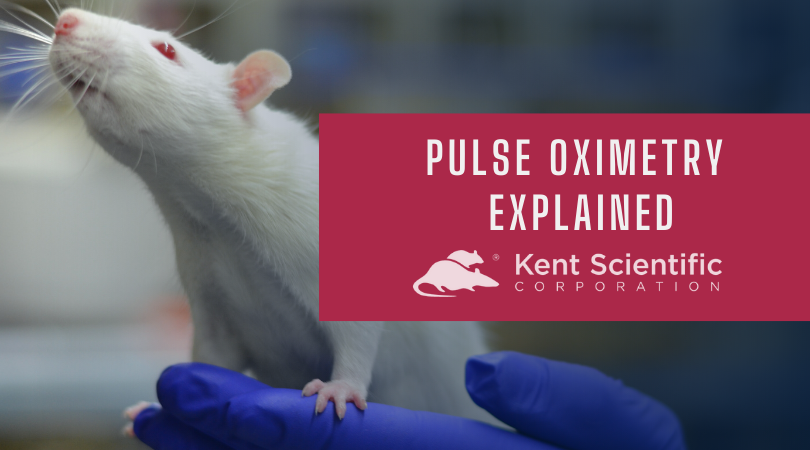Pulse Oximetry Explained
Posted on
With continuing advances in medical research, small animals such as rats, mice, and gerbils are being used as surgical models. Advanced monitoring devices have been developed to monitor subjects during surgery to improve surgical outcomes and consider increasing concern for humane practices. These devices monitor several vital signs, including blood pressure, heart and respiratory rate, and oxygen saturation level (SpO2).
 Although pulse oximetry has been available in human clinical practice since the 1980s, it wasn’t until much later that a workable pulse oximetry sensor was available for use on small animals 1. Differences in heart rate and sampling time were some of the challenges encountered.
Although pulse oximetry has been available in human clinical practice since the 1980s, it wasn’t until much later that a workable pulse oximetry sensor was available for use on small animals 1. Differences in heart rate and sampling time were some of the challenges encountered.
Nonetheless, the small animal pulse oximetry sensor has helped fuel advances in life science research.
What Is a Pulse Oximetry Sensor?
Compared to the more accurate (but invasive) measurement of oxygen saturation levels by arterial blood gas analysis, pulse oximetry is a noninvasive and inexpensive method of measuring these levels 2.
Red blood cells carry millions of hemoglobin molecules which become saturated once bound to oxygen.
Even to the naked eye, de-oxygenated blood appears darker than oxygenated blood. A pulse oximetry sensor measures the amount of oxygenated hemoglobin in blood to reveal oxygen saturation levels 3.
A pulse oximetry sensor is attached to a body part, such as the finger, ear, or foot. One aspect of the sensor transmits red and infrared light signals, while another part receives these signals. Oxygenated hemoglobin absorbs more infrared light than de-oxygenated hemoglobin. It also transmits more red light.
The red to infrared light ratio provides an oxygen saturation measurement. For example, a 96% SpO2 reading means that 96% of red blood cells are oxygen saturated. A pulse oximetry sensor reads the pulsatile (arterial) element of blood flow. Since 98% of oxygen is transported by hemoglobin, pulse oximetry is a reliable clinical indicator of oxygen saturation, with a confidence rate in 95% ± 4% 2,4.
Using a Pulse Oximetry Sensor on Small Animals
In 2011, the National Research Council in the United States updated its guidance on the use and care of laboratory animals to include the use of pulse oximetry for arterial oxygen analysis 5. Laboratory managers should consider species type, heart rate, skin pigmentation, and other factors when selecting a pulse oximetry sensor for their research.
Pulse oximetry sensors for rodents and small animals are adapted to capture small, high-frequency arterial pulsations: For instance, while the average human heart rate is between 70 and 80 bpm at rest, it is over 300 bpm for mice 6,7. Conversely however, arterial pulsation (perfusion) is weaker in mice.
While in humans, a pulse oximetry sensor is typically placed on the finger, ear, or large surface area, it is usually placed on the paw, throat, thigh, or tail in a rodent. Some of the challenges of applying a pulse oximetry sensor to a small animal include:
- Finding sensors which fit the anatomy of the animal
- Finding sensors that are sensitive to high-frequency, low perfusion arterial pulsations
- Finding sensors that are multifunctional yet have a low footprint
Challenges of Using a Pulse Oximetry Sensor
While a small animal or mouse pulse oximeter sensor provides noninvasive oxygenation and pulse rate information, there are significant limitations to consider:
Firstly, incorrect measurements can be caused by incorrect sensor application, interference from light, movement of the subject, skin pigmentation, calloused skin, low pulse quality, and other factors.
Also, since a pulse oximetry sensor only measures hemoglobin saturation, it does not provide a complete picture of respiratory efficiency. For example, it does not indicate blood oxygen content, carbon dioxide or blood pH levels.
Even when SpO2 (oxygen bound to hemoglobin) and PaO2 (oxygen not bound to hemoglobin) give regular readings, this is not a sufficient indication of CaO2 (arterial blood content being delivered to tissues). For this, hemoglobin levels must be measured 8.
Moreover, under general anesthesia, a patient breathing 100% oxygen may show high PaO2 and SpO2. Consequently, PaO2 readings would have to fall to dangerously low levels for SpO2 changes to become noticeable.
Pulse oximetry provides information on oxygen transport, not on the delivery of oxygen to tissues. For instance, in anemic patients, even though hemoglobin may still become saturated, the blood contains less hemoglobin and consequently delivers less oxygen to tissues.
Sources:
- Rigotti, C., et. al. (2011) Pulse oximetry use in small animals. [online] Available at: https://www.vettimes.co.uk/app/uploads/wp-post-to-pdf-enhanced-cache/1/pulse-oximetry-use-in-small-animals.pdf
- DeMeulenaere, S. (2007) Pulse Oximetry: Uses and Limitations. The Journal for Nurse Practitioners, [online] Vol. 3, Issue 5, pp 312-317. Available at: https://www.npjournal.org/article/S1555-4155(07)00210-3/fulltext
- Cables and Sensors. Pulse Oximetry: The Definitive Guide for Monitoring Oxygen Saturation. [online] Available at: https://www.cablesandsensors.com/pages/what-is-pulse-oximetry-the-definitive-guide-for-monitoring-oxygen-saturation-levels
- Pittman, R. (2011) Regulation of Tissue Oxygenation. National Library of Medicine, [online] Chapter 4, Oxygen Transport. Available at: https://www.ncbi.nlm.nih.gov/books/NBK54103/
- Institute for Laboratory Animal Research (2011) Guide for the Care and Use of Laboratory Animals. [online] Available at: https://grants.nih.gov/grants/olaw/Guide-for-the-Care-and-Use-of-Laboratory-Animals.pdf
- John Hopkins University. The Mouse. Animal Care and Use Committee [online] Available at: https://web.jhu.edu/animalcare/procedures/mouse.html
- Healthline. Normal vs. Dangerous Heart Rate: How to Tell the Difference. [online] Available at: https://www.healthline.com/health/dangerous-heart-rate
- Alfaxan. Pulse Oximetry and Oxygenation. [online] Available at: https://alfaxan.co.uk/news/practical-pulse-oximetry